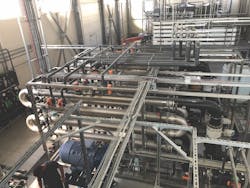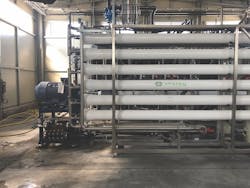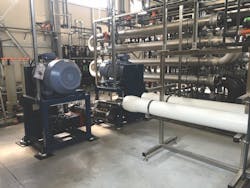About the author:
Ulrich Baeuerle is chief technology officer for APATEQ. Baeuerle can be reached at [email protected].
It is estimated that more than 2 million tons of sewage, industrial and agricultural waste is discharged every day into global water ways. APATEQ’s water treatment systems filter contaminated wastewater to produce water of drinking quality standard that can be safely used for irrigation of crops or just safely released into rivers.
Leachate that escapes from a landfill site can contaminate groundwater, surface waters and soil, potentially polluting the environment and harming human health. European Union legislation governs landfills and leachate management in the EU to prevent or reduce harmful effects on the environment and human health during the whole lifecycle of the landfill.
Ultrafiltration & Reverse Osmosis Sequencing
Ultrafiltration (UF) and reverse osmosis (RO) are the processes used for the transition of landfill leachate to water of drinking quality standard and is a challenge due to high concentration of particles, salts like potassium, chloride and ammonia and organic materials. The key considerations when finding a high-pressure RO pump to combat these challenges are reliability with minimal maintenance and high efficiency.
APATEQ installed Wanner Hydra-Cell ultra-high-pressure RO process pumps for use in a landfill water treatment system. The facility required three pumps for use within five RO stages for processing leachate, the first of which was ultrafiltration. This took place at a treatment plant run by the largest private landfill owner in Sicily, Italy.
The ultrafiltration pre-treatment removes nearly all suspended solids and microorganisms from the contaminated water. Following that is three-stage RO used to treat the UF permeate, which removes the rest of the dissolved salts and other organic solubles. The effluent water is purified enough to achieve drinking water quality at this point. Additionally high-pressure RO systems are used to reduce the volume of the first RO stage brine flow.
One Wanner Hydra-Cell T100H pump pumps water to the through stage one RO and two Wanner Hydra-Cell T100K pumps run parallel to each other through the high pressure RO stage. The permeate from stage one is then sent through the next low pressure RO stages to post treat that permeate.
The high-pressure pumps are running up to 10 cubic meters per hour at 120 bar (1740 psi) for the two high pressure RO systems, and up to 15 cubic meters per hour at 80 bar for the RO stage one process.
Putting The Treatment Into Practice
Using these processes, the contaminated water from the landfill site is turned into drinking water quality, providing cost savings by eliminating the need for transporting and disposing the leachate to an external facility on the Italian mainland. The operating costs was around €100 per cubic meter, which ultimately had a large impact on the client’s bottom line when processing 300 cubic meters per day.
Since the new process plant has been running, the operating cost for processing has decreased to less than €10 per cubic meter. This is a total cost saving of up to 90%. An extension to 600 cubic meters per day is planned for installation in autumn 2020 and operation will start end of 2020. Considering the United Nations has estimated that more than 1,500 cubic km of wastewater is produced each year, the potential cost saving globally is vast.
Energy Savings Discovery
Furthermore, while working for a site that produces its own electricity, it was discovered the pump saves on energy usage and therefore costs too.
The centrifugal pumps used in other wastewater treatment processes in the past had a higher electricity usage when used for continuous duty, which is more costly. The high efficiency and low horsepower requirement of the new pumps dramatically reduced energy costs, while remaining reliable, resulting in further cost savings for servicing and maintenance.
These results were a key factor in the decision to use the pumps. Depending on the process stage, the pumps need to run at 120 bar pressure continuously. Regular and frequent maintenance on pumps that previously were used at 120 bar involved replacement of expensive packing, seals and springs every six months, which inevitably effected operational efficiency.
In comparison, the new pumps now used have significantly lower maintenance requirements and costs, which leads to greater productivity. Put simply, they do not break down and can be relied upon day in and day out.
APATEQ’s process lowers the amount of ammonia in leachate from up to 5,500 mg/L down to less than two. The process also reduces chemical oxygen demand levels from between 20,000 to 40,000 mg/L to 5 t0 10mg/L.
The Flow of Operations
Maintaining a constant flow and pressure is essential for a good operation of the whole plant and for removing all dissolved contaminants and microorganisms from the leachate. When processing a high concentration of chloride in the process liquid, the seals and packing in pumps can quickly deteriorate.
High salt concentrations within the leachate can cause damage to pumps, which have dynamic seals and packing. The Hydra-Cell pumps can reliably handle liquids containing particles from 0.1 to 800 microns and more abrasives with less wear than on axial piston or plunger pumps.
The seal-less design of the pumps enables reliable handling of the process liquids, eliminating unplanned downtime and again, reducing maintenance costs associated with the need to replace expensive seals and packing. It also ensures 100% leak-free operation and safety for operators and for the environment, as there is no risk of hazardous liquids leaking from the pumps.
The pumps can reliably and efficiently pump leachate within the RO stages, which are a part of the complete wastewater treatment system. The seal-less design provides cost savings, whilst easily handling abrasive compounds, heavy metals, fine particles and corrosive liquids. This enables the process to reduce the environmental impact of wastewater contamination entering water ways.


